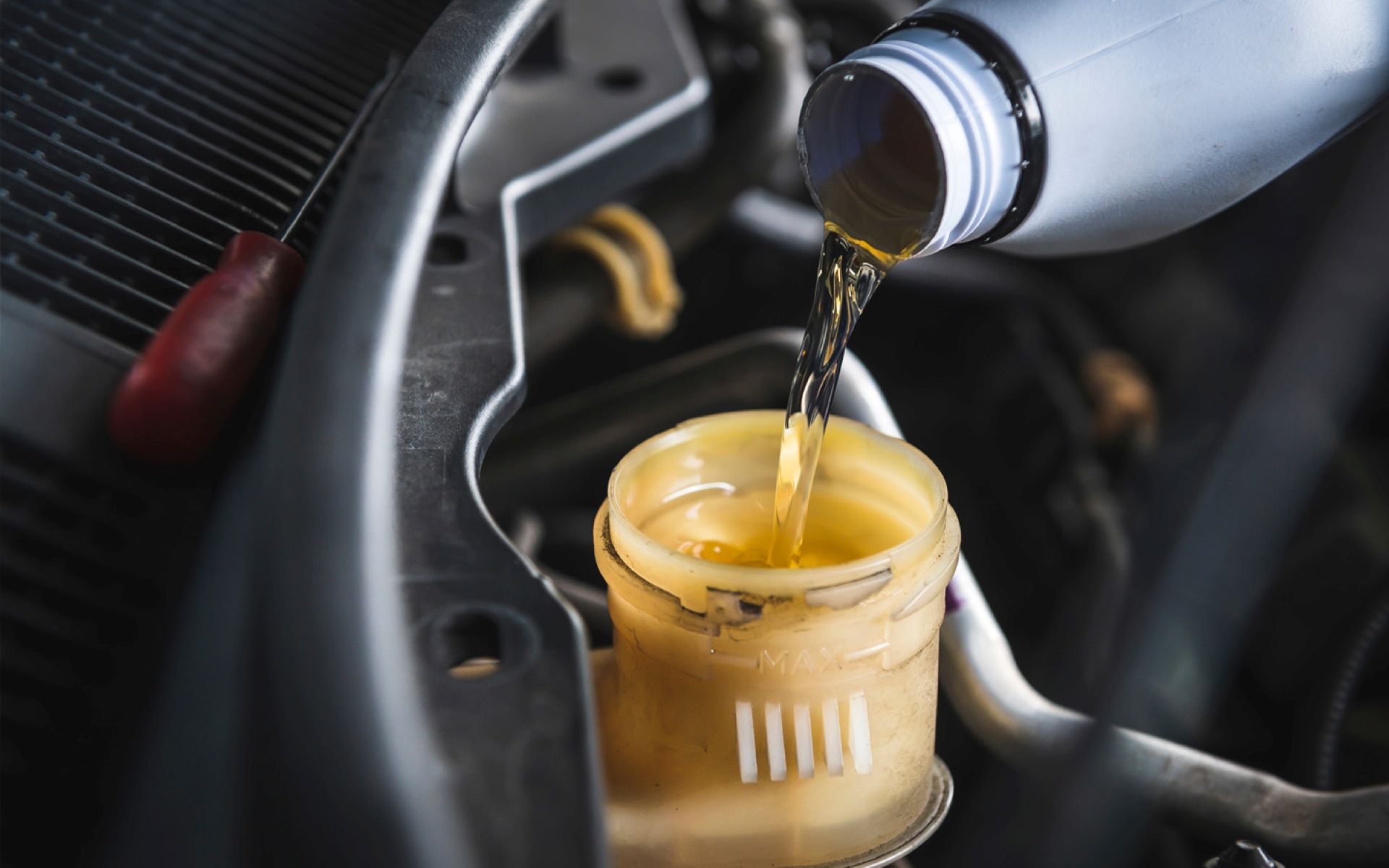Home>Automotive>The Ultimate Brake Fluid Hack: Mixing DOT3 And DOT4 – What You Need To Know!


Automotive
The Ultimate Brake Fluid Hack: Mixing DOT3 And DOT4 – What You Need To Know!
Published: January 23, 2024
Learn the essential tips for mixing DOT3 and DOT4 brake fluid in automotive vehicles. Find out everything you need to know for optimal performance and safety!
(Many of the links in this article redirect to a specific reviewed product. Your purchase of these products through affiliate links helps to generate commission for Regretless.com, at no extra cost. Learn more)
Table of Contents
Introduction
Brake fluid is a critical component of a vehicle's braking system, responsible for transmitting the force from the brake pedal to the brake pads. It operates under high temperatures and pressure, making it essential for ensuring safety on the road. There are various types of brake fluids available, with DOT3 and DOT4 being among the most commonly used options. Understanding the differences between these two types of brake fluids and the possibility of mixing them is crucial for maintaining the optimal performance of your vehicle's braking system.
In this comprehensive guide, we will delve into the intricacies of DOT3 and DOT4 brake fluids, exploring their unique characteristics and shedding light on the often-debated topic of mixing these two types. By the end of this article, you will gain valuable insights into the potential implications, both positive and negative, of combining DOT3 and DOT4 brake fluids. Additionally, we will provide expert advice on how to safely execute this process, ensuring that you can make informed decisions when it comes to maintaining your vehicle's braking system.
Without further ado, let's embark on a journey through the world of brake fluids, uncovering the ultimate brake fluid hack and equipping you with the knowledge you need to make the best choices for your vehicle's safety and performance.
What is DOT3 Brake Fluid?
DOT3 brake fluid is a type of hydraulic fluid specifically formulated for use in automotive braking systems. It is renowned for its ability to withstand high temperatures and effectively transfer force from the brake pedal to the brake components. DOT3 brake fluid is glycol-based, making it hygroscopic, which means it has a tendency to absorb moisture from the surrounding environment over time. This characteristic is a crucial consideration for vehicle owners, as moisture absorption can lead to a decrease in the boiling point of the brake fluid, potentially compromising its performance under extreme conditions.
One of the defining features of DOT3 brake fluid is its compatibility with a wide range of vehicles, including those equipped with disc or drum brakes. This versatility has contributed to its widespread use in the automotive industry. Additionally, DOT3 brake fluid meets the specifications set by the Department of Transportation (DOT), ensuring that it adheres to the necessary standards for safe and reliable operation in vehicles.
When selecting brake fluid for your vehicle, it's essential to verify that the chosen product meets the DOT3 specifications. This validation guarantees that the brake fluid possesses the requisite properties to function optimally within the braking system. Furthermore, adhering to the manufacturer's recommendations regarding the type of brake fluid to use is paramount, as it ensures compatibility with the vehicle's braking components and maintains the overall safety and performance standards.
In summary, DOT3 brake fluid is a vital component of a vehicle's braking system, characterized by its glycol-based composition, high-temperature resilience, and compatibility with various automotive applications. Understanding the fundamental properties of DOT3 brake fluid is pivotal for making informed decisions regarding the maintenance and performance of your vehicle's braking system.
What is DOT4 Brake Fluid?
DOT4 brake fluid is a hydraulic fluid designed for use in automotive braking systems, renowned for its exceptional performance under high-stress conditions. Similar to DOT3 brake fluid, DOT4 is glycol-based, offering hygroscopic properties that enable it to absorb moisture from the surrounding environment. This characteristic is pivotal in maintaining the integrity and functionality of the braking system, as it helps prevent the formation of air bubbles or vapor within the hydraulic components.
One of the distinguishing features of DOT4 brake fluid is its notably higher boiling point compared to DOT3. This elevated boiling point is attributed to the fluid's formulation, which includes additives to enhance its resistance to heat. As a result, DOT4 brake fluid is well-suited for vehicles that undergo rigorous braking conditions, such as those used for towing or heavy-duty applications. The increased boiling point of DOT4 brake fluid reduces the likelihood of vapor lock, a phenomenon that can impair brake responsiveness and effectiveness.
Furthermore, DOT4 brake fluid meets the stringent specifications outlined by the Department of Transportation (DOT), ensuring that it complies with the necessary standards for safe and reliable operation in vehicles. Its compatibility with a wide range of automotive braking systems, including those equipped with advanced anti-lock braking systems (ABS), makes it a popular choice among vehicle owners seeking optimal performance and safety.
When considering the selection of brake fluid for your vehicle, it is crucial to adhere to the manufacturer's recommendations and specifications. By consulting the vehicle's manual or seeking guidance from a qualified automotive professional, you can ensure that the chosen brake fluid aligns with the requirements of the braking system.
In summary, DOT4 brake fluid stands out for its superior heat resistance, higher boiling point, and compatibility with diverse automotive applications. Understanding the unique attributes of DOT4 brake fluid empowers vehicle owners to make informed decisions regarding the maintenance and performance of their braking systems, ultimately contributing to the safety and reliability of their vehicles.
Can DOT3 and DOT4 Brake Fluids be Mixed?
The question of whether DOT3 and DOT4 brake fluids can be mixed is a topic of considerable debate and scrutiny within the automotive community. While both types of brake fluids share similarities in their glycol-based compositions and hydraulic properties, there are crucial differentiating factors that must be taken into account when considering the possibility of mixing them.
It is important to note that brake fluid is a fundamental component of a vehicle's safety system, and any decision related to its maintenance and handling should be approached with utmost caution and adherence to industry best practices. Mixing DOT3 and DOT4 brake fluids can have both advantages and potential drawbacks, necessitating a comprehensive understanding of the implications.
In certain scenarios, such as topping off the brake fluid reservoir, a small amount of mixing between DOT3 and DOT4 may occur. However, deliberately mixing significant quantities of these two types of brake fluids is generally not recommended. The primary reason behind this caution is the varying chemical compositions and performance specifications of DOT3 and DOT4 brake fluids.
DOT3 brake fluid, being more hygroscopic than DOT4, has a lower boiling point and is prone to moisture absorption. On the other hand, DOT4 brake fluid, with its higher boiling point and enhanced resistance to heat, is formulated to meet the demands of advanced braking systems. Mixing these two types of brake fluids can potentially compromise their individual properties, leading to diminished performance and safety risks.
While some argue that a small amount of mixing may not cause immediate issues, it is essential to consider the long-term implications. The compatibility of mixed brake fluids with the vehicle's braking components, the potential impact on the boiling point and viscosity, and the overall safety implications must be thoroughly evaluated.
In summary, while incidental mixing of DOT3 and DOT4 brake fluids may occur in certain circumstances, deliberate mixing of significant quantities is generally discouraged due to the potential risks and uncertainties associated with the combined properties. Vehicle owners and automotive professionals are advised to adhere to the manufacturer's recommendations and specifications when it comes to selecting and maintaining brake fluids, ensuring optimal performance and safety.
Pros and Cons of Mixing DOT3 and DOT4 Brake Fluids
Mixing DOT3 and DOT4 brake fluids can elicit both advantages and potential drawbacks, prompting a comprehensive evaluation of the implications. Understanding the pros and cons of this practice is crucial for vehicle owners and automotive professionals seeking to make informed decisions regarding the maintenance and performance of their braking systems.
Pros of Mixing DOT3 and DOT4 Brake Fluids
-
Convenience: One potential advantage of mixing DOT3 and DOT4 brake fluids is the convenience it offers in situations where only a small amount of brake fluid is required. This can be particularly relevant when topping off the brake fluid reservoir, where incidental mixing may occur. However, it is important to exercise caution and limit the extent of mixing to minimize potential adverse effects.
-
Compatibility: In some cases, mixing DOT3 and DOT4 brake fluids may not immediately result in noticeable issues, especially when small quantities are involved. This can be advantageous in emergency situations where access to a specific type of brake fluid is limited. However, it is essential to recognize that the long-term implications of such mixing should be carefully considered to avoid compromising the performance and safety of the braking system.
Cons of Mixing DOT3 and DOT4 Brake Fluids
-
Performance Implications: One of the primary drawbacks of mixing DOT3 and DOT4 brake fluids is the potential compromise in performance. The varying chemical compositions and performance specifications of these two types of brake fluids can lead to altered properties when combined, potentially impacting the boiling point, viscosity, and overall effectiveness of the brake fluid. This can introduce safety risks and diminish the reliability of the braking system.
-
Safety Risks: Mixing significant quantities of DOT3 and DOT4 brake fluids can pose safety risks, as it may lead to uncertainties regarding the compatibility with the vehicle's braking components. The potential impact on the hydraulic system's functionality and the formation of air bubbles or vapor within the brake lines must be carefully considered to prevent compromising the safety and reliability of the braking system.
In summary, while there may be instances where mixing DOT3 and DOT4 brake fluids offers convenience, it is essential to approach this practice with caution due to the potential performance implications and safety risks associated with the combined properties. Adhering to the manufacturer's recommendations and specifications for brake fluid selection and maintenance remains crucial in ensuring the optimal performance and safety of the vehicle's braking system.
How to Safely Mix DOT3 and DOT4 Brake Fluids
When it comes to the safe mixing of DOT3 and DOT4 brake fluids, it is important to approach this process with meticulous care and attention to detail. While deliberate mixing of significant quantities of these two types of brake fluids is generally discouraged due to potential performance implications and safety risks, there are certain scenarios where limited mixing may occur. Here are important considerations for safely managing the mixing of DOT3 and DOT4 brake fluids:
-
Understanding the Brake System: Before considering any form of brake fluid mixing, it is crucial to have a comprehensive understanding of the specific requirements and characteristics of the vehicle's braking system. This includes identifying the type of brake fluid recommended by the manufacturer, understanding the capacity of the brake fluid reservoir, and being aware of any existing brake maintenance or repair activities.
-
Verification of Compatibility: Prior to any mixing, it is essential to verify the compatibility of the DOT3 and DOT4 brake fluids with the vehicle's braking components. This involves consulting the vehicle's manual or seeking guidance from a qualified automotive professional to ensure that the selected brake fluids align with the specifications and requirements of the braking system.
-
Minimizing Mixing: In situations where limited mixing of DOT3 and DOT4 brake fluids may occur, such as when topping off the brake fluid reservoir, it is important to minimize the extent of mixing. This can be achieved by carefully measuring and adding the required brake fluid to avoid excessive blending of the two types.
-
Preventing Contamination: To maintain the integrity of the brake fluid, it is imperative to prevent contamination during the mixing process. This includes using clean and properly sealed containers for storing and dispensing the brake fluid, as well as ensuring that the surrounding environment is free from debris or moisture that could compromise the quality of the fluids.
-
Consultation with Professionals: When in doubt or when facing unique circumstances that may necessitate brake fluid mixing, seeking advice from automotive professionals or qualified technicians is highly recommended. These experts can provide valuable insights and guidance tailored to the specific requirements of the vehicle's braking system.
By adhering to these guidelines and exercising caution, vehicle owners can navigate the process of mixing DOT3 and DOT4 brake fluids in a manner that prioritizes safety, performance, and the overall integrity of the braking system. It is important to emphasize that while limited mixing may occur in certain situations, deliberate mixing of significant quantities should be approached with extreme care and consideration of the potential implications.
Conclusion
In conclusion, the world of brake fluids encompasses a myriad of considerations, from understanding the unique properties of DOT3 and DOT4 brake fluids to navigating the potential implications of mixing these two types. The safety and performance of a vehicle's braking system hinge upon the informed decisions made by vehicle owners and automotive professionals. Therefore, it is imperative to approach the maintenance and handling of brake fluids with meticulous care and adherence to industry best practices.
The distinction between DOT3 and DOT4 brake fluids lies not only in their chemical compositions but also in their performance specifications and compatibility with diverse automotive applications. While both types exhibit hygroscopic properties, DOT4 brake fluid stands out for its higher boiling point and enhanced resistance to heat, making it suitable for demanding braking conditions. On the other hand, DOT3 brake fluid offers versatility and widespread compatibility with various vehicles, emphasizing the importance of selecting the appropriate brake fluid in accordance with the manufacturer's recommendations.
The debate surrounding the mixing of DOT3 and DOT4 brake fluids underscores the need for a balanced understanding of the potential advantages and drawbacks associated with this practice. While limited mixing may occur incidentally in certain scenarios, deliberate mixing of significant quantities is generally discouraged due to the potential compromise in performance and the introduction of safety risks. Vehicle owners are encouraged to prioritize caution and consult automotive professionals when faced with unique circumstances that may necessitate brake fluid mixing.
Safeguarding the integrity and functionality of the braking system requires a proactive approach, including a comprehensive understanding of the vehicle's brake system, verification of brake fluid compatibility, and meticulous care in managing the mixing process. By adhering to these principles and seeking guidance when needed, vehicle owners can uphold the safety and reliability of their vehicles' braking systems, ultimately contributing to a secure and confident driving experience.
In essence, the ultimate brake fluid hack lies not in the mixing of DOT3 and DOT4 brake fluids, but in the informed decision-making and conscientious maintenance practices that prioritize the safety and performance of the vehicle. By embracing a proactive and informed approach to brake fluid management, vehicle owners can navigate the complexities of the automotive world with confidence, ensuring that their vehicles operate at optimal safety and performance levels.














